Why would you want to get in the Flow?
and 10 ways to tell when you're in it
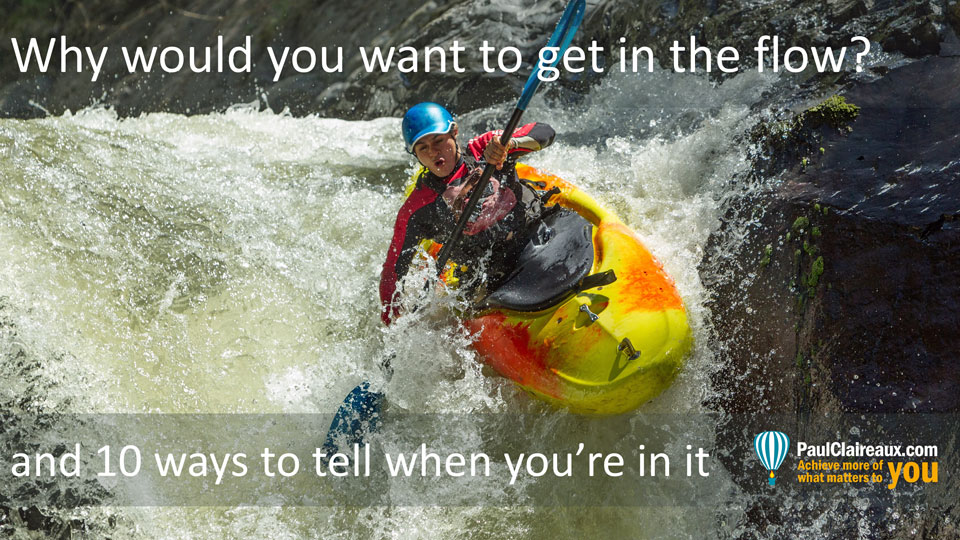
If you’re striving to achieve more of the things that matter to you, this Insight on getting into the ‘Flow’ will help.
2 to 5 minute read, depending on your speed.
Flow can help you exceed normal limits of work
We explored in this other Insight why being somewhat, but not too busy is key to being effective.
Research from Yerkes and Dodson (from 1908!) showed, for knowledge workers – as many of us are, that:
- If we do too little work, we fail to become effective at the little we do!
- As we increase our work levels, our performance quality also rises, but typically, only up to a point.
- If we push ourselves beyond that point, our output quality will often fall off.
- If we push harder still, perhaps in an attempt to make up for that fall off, we risk a collapse in our performance*
(* That’s called burnout, by the way. It’s a place I’ve been to, and do not recommend!)
It’s also worth noting that peak activity levels vary between people, activities and environments – including the leadership you experience from your manager if you have one.
Who works effectively for a terrible boss?
As the saying goes,
People tend to leave bosses, not businesses.
Now, that’s all good theory in many employed situations, but what’s going on with highly skilled and creative people when they work for very long periods, sometimes into the early hours, apparently without ill effect!
This is the fascinating ‘flow’ phenomenon we’ll explore here.
Flow (often) starts with a purpose
In his excellent book, Drive, Dan Pink suggests that the most attractive work offers us elements of Autonomy, Mastery and Purpose.
To remember those elements, just take the first letter of each to get AMP. It’s an electrifying acronym 😉
‘Drive’ is one of my favourite books which you’ll find listed here – in two sections about:
- Achieving more – and finding more happiness in life.
- Understanding your money and making better decisions about it
Finding (or creating) work with a purpose is really about understanding what you deliver, and most organisations do deliver benefits to their clients/customers.
That said, not every organisation (private or public) delivers real benefits at a fair price. And if you can’t honestly say that yours does, you might want to make plans to change your job (or change your customer propositions if you run your own business) when the time is right.
Work that has no purpose is unlikely to survive very long, and that’s especially true in these challenging times.
Yes, I know new jobs are difficult to find right now, so you might need to explore projects outside of your work (or study to make yourself more marketable) until the jobs market improves.
Just taking the first few (tentative) steps towards doing more purposeful work can be extraordinarily uplifting.
I’m also aware that many of us work very long hours already but here’s the thing.
With purposeful activity almost any workload is possible.
It can even be enjoyable!
“Oh, come on”, I hear you say, “Are you serious… any amount of work?”
Yes, I’m perfectly serious. This is what ‘Flow’ is all about.
Flow, in a nutshell
You’ve probably heard of being ‘in the zone’ or ‘in the flow’ because the idea has been around for decades, but what is it, exactly?
Flow is the mental state we get into when we’re completely immersed in, and absorbed/energised by some kind of activity.
Look at this image, from, ‘Finding Flow, the psychology of engagement with everyday life’
It compares ‘Flow’ to other mental states we might experience according to our abilities and the level of challenge we face while performing a demanding activity.
If you think about learning any demanding activity (to play a musical instrument, paint a picture, code a program, write a book or blog) it’s easy to imagine being in any one of these states.
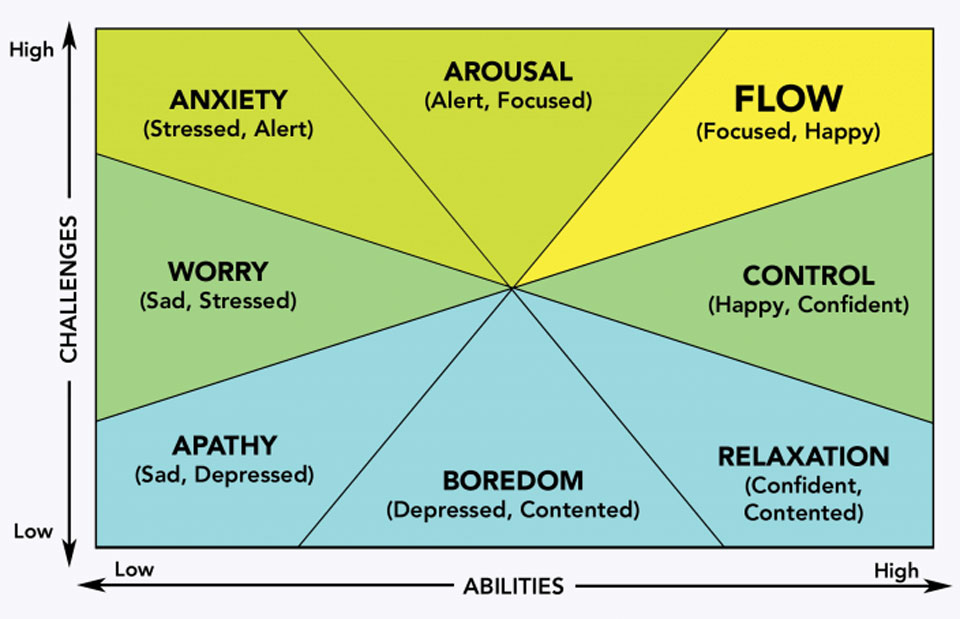
Further observations
- Flow is a useful mental state to get into, but you can’t expect to get into it overnight; you need to develop some abilities first.
- Give yourself time but not too much time in the Flow. The high challenge levels result in absorption and a lost sense of time. So, you need to be aware – perhaps set alarms – to take breaks to eat and exercise occasionally too.
- Flow can be viewed as a productive form of hyperfocus. Less positive forms include spending all day on a video game to the detriment of your essential work. So, watch out for that!
Who developed this ‘flow’ idea?
As with many things in Psychology, I imagine we’ve known about Flow as an experience (esp. in Eastern thought systems like Buddhism- but described in other terms) for thousands of years.
However, the acknowledged main academic work on ‘flow’ was started in the 1960s by an American-Hungarian Psychologist called Mihaly Csikszentmihalyi – not an easy name to pronounce, so I’ll refer to him as Mihaly here.
Mihaly researched this area because he was fascinated by artists, other creators, designers and developers, who become so immersed in their work that they sometimes disregarded the need for food, water, or even sleep!
The word ‘flow’ came from interviews Mihaly conducted with these artists in 1975, in which they compared their experience of intense work to that of being carried along by fast-flowing water. And this makes perfect sense, even if you’ve never done anything like this, it’s obvious that you can’t ‘step off the boat’ at these times.
You just have to press on and deal with the challenge that’s staring you right in your face!
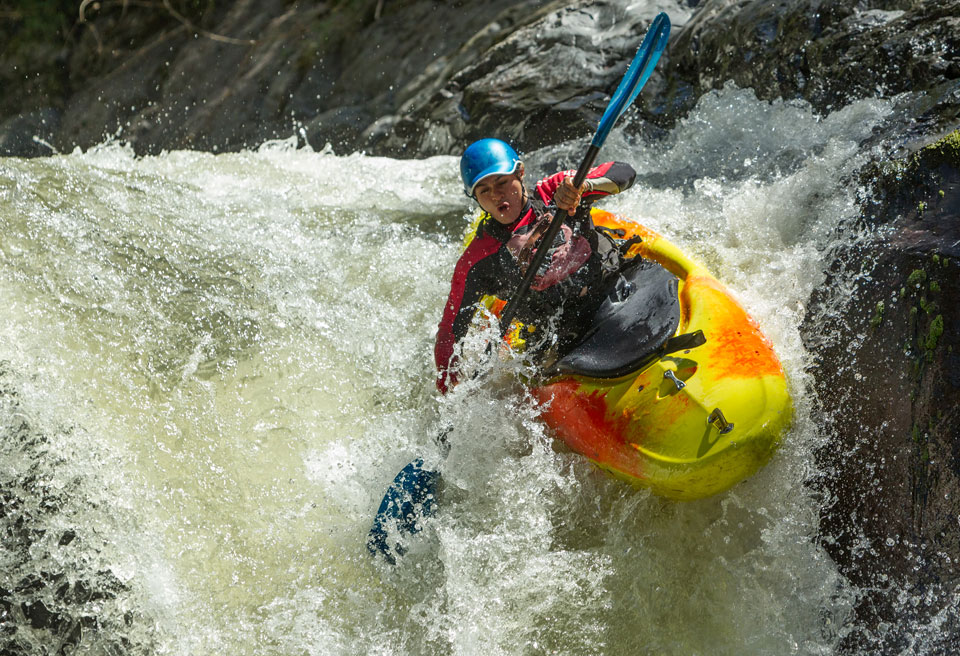
The difference with ‘flow’ as a mental state is that we’re not just carried along by something like a water current; we also create the current that carries us.
Mihaly published his ideas in a best-selling book, ‘Flow, the psychology of optimal experience’ in 1992 which is listed on my books IRATE page here.
This chart, from that book, illustrates the idea of a flow channel as being the best area to aim for – as we build our skills.
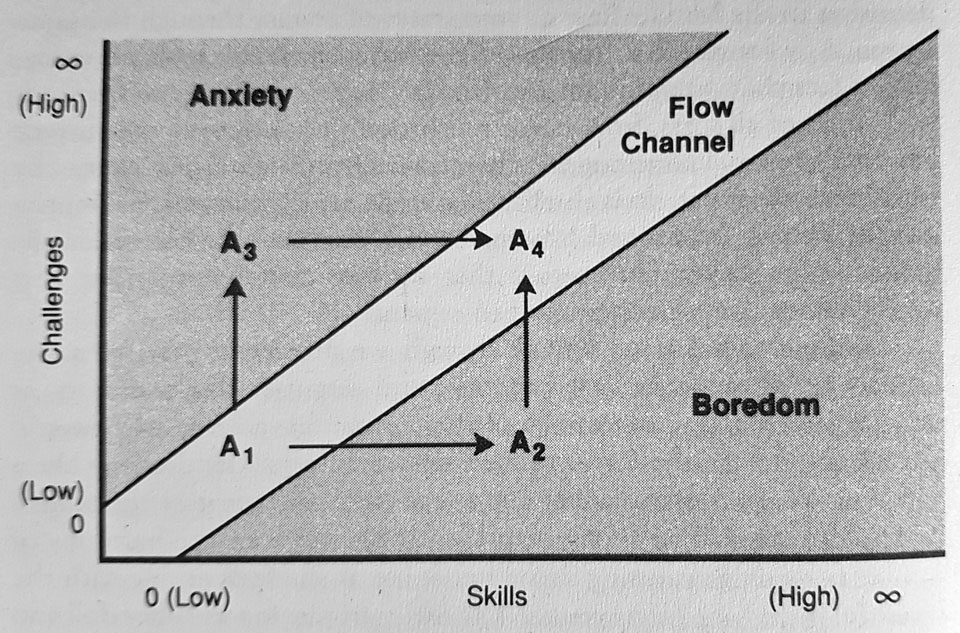
This is the Goldilocks zone if you like.
If you find yourself bored by your challenges as your skills increase (from A1 to A2 in the diagram), you need to increase the level of challenges you take on (to A4)
Alternatively, if you take on too big a challenge for your abilities, and find yourself getting anxious, you need to focus on improving your skills. (A3 to A4)
Like most brilliant ideas – it’s deceptively simple!
What Flow is not
Apologies if this states the obvious but just to be clear… ‘Flow’ has nothing to do with ‘going with the flow’, a phrase used to describe an easy-going attitude.
‘Going with the flow’ is not so much a state of mind as a ‘carefree’ attitude in which we’re extremely unlikely to create much of value.
That said, there’s no harm in being ‘laid back’ and ‘going with the flow’ sometimes – and then switching to a more productive ‘flow’ mental state to get stuff done, at other times.
We’re human after all; we need to rest sometimes – and we also have many roles to play in life.
Ten ways to tell you’re in ‘Flow’
Mihaly identified ten factors typically associated with ‘Flow’.
You don’t need all ten to be in it; you’re just more likely to be in it if several of these factors apply.
The ten factors are:
1. A clear goal, aligned with our skills and abilities.
2. Concentration and focus on a limited subject field, requiring us to delve deeper into it.
3. A loss of self-consciousness: actions and awareness merge to become simply fast-flowing actions.
4. A distorted sense of time and a sense of surprise at how long we spent on the task.
5. Unambiguous feedback: success and failure in our activity are immediately apparent prompting us to correct our work while we do it. (Incidentally, if writing is your ‘flow’ activity, try using a grammar checking tool, like Grammarly, to get this clear feedback as you write)
6. A balance between ability level and challenge: the activity is in the Goldilocks zone.
7. A sense of personal control over the activity.
8. A sense of intrinsic reward from the activity
9. A lost awareness of hunger, or fatigue.
10. A sense of being absorbed into the activity as our awareness focus narrows.
How to get into the Flow
Mihaly’s first book is wonderful if you’re interested in the years of research behind these observations, but I’m sure he wouldn’t mind me saying, it’s not an easy read!
My suggestion, if you’ve not yet experienced being in the ‘flow’, is to simply start working vigorously on something that you care about – using the skills that you have.
You might just find yourself in the ‘Flow’ before you know it!
And if there’s something you want to do that you’re not yet skilled at, start learning those skills soon, and get help from a coach if you need it.
It would be a pity to miss out on the experience of ‘Flow’ and an even greater shame to achieve a lot less than you’re capable of.
Most of us can achieve more than we think, and that’s why the idea is my logo.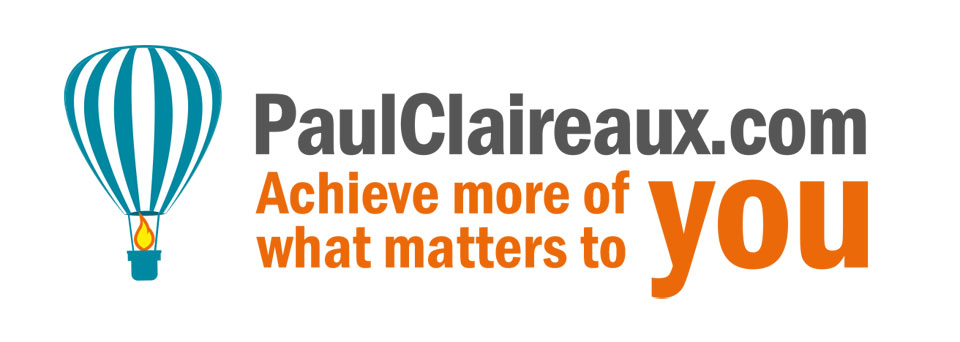
Do you need help?
If you’re looking for a coach (someone to bounce your ideas off, learn from, challenge you to achieve more of what matters to you) choose the right person.
The skills, knowledge and experience of coaches vary enormously, and their fee levels are not necessarily correlated with the value they add!
Here are some ideas on what a good coach looks like and if you believe I could help you, let’s chat about that.
Hope that’s been useful, and good luck on the next stage of your journey.
Thanks for dropping in
Paul
For more ideas to achieve more in your life and make more of your money, sign up to my newsletter
As a thank you, I’ll send you my ‘5 Steps for planning your Financial Freedom’ and the first chapter of my book, ‘Who misleads you about money?’
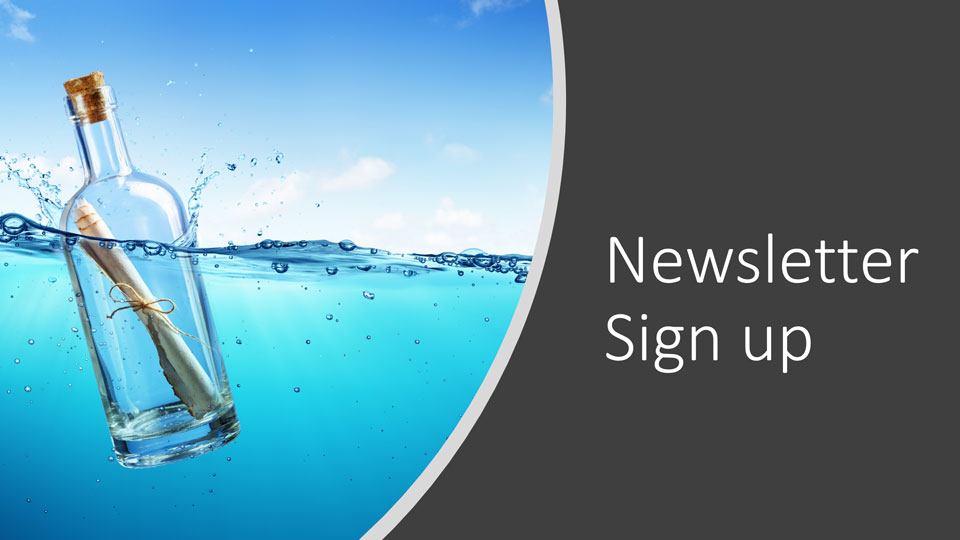
Also, for more frequent ideas – and more interaction – you can join my Facebook group here
Share your comments here
You can comment as a guest (just tick that box) or log in with your social media or DISQUS account.

Discuss this article